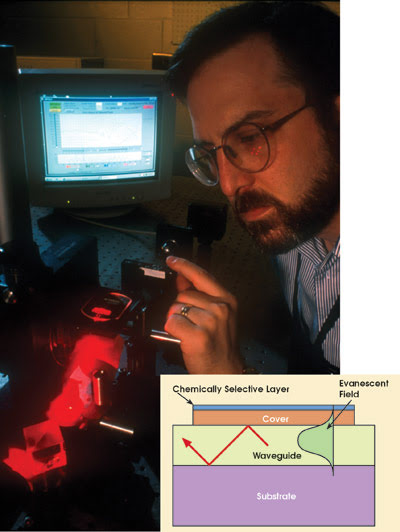Daniel S. Burgess, Senior Editor
If you live in the US, chances are you’re
having chicken for dinner tonight. A significant percentage of that chicken is probably
contaminated with pathogens, so governmental agencies and the industry monitor the
inspection line to determine if the meat should be discarded, if remediation efforts
should be tweaked or if a recall should be issued.
An optical sensor under development
by David S. Gottfried’s team at Georgia Tech Research Institute in Atlanta
promises to improve this process. Incorporating a commercially available laser diode,
an optical waveguide chip and an inexpensive CCD camera, the sensor has demonstrated
that it can detect salmonella, and can do so much more quickly than other techniques.
It next has its sights on Campylobacter.

Scientists at Georgia Tech Research Institute are working on an optical biosensor that detects the presence of a contaminant by observing the phase of a light beam through the sensing region compared with the light traveling through a reference channel. Pathogens that bind to the chemically selective layer perturb the evanescent electric field of the light in the waveguide, changing the interference pattern at the CCD detector.
It is virtually impossible to prevent
the exposure of livestock to salmonella or Campylobacter. Some of those pathogens
inevitably make their way into the processing plant. Willie L. Willis, a professor
of poultry science at North Carolina Agricultural and Technical State University
in Greensboro, suggested a figure of 25 to 40 percent for salmonella contamination.
His research indicates that about 66 percent of raw chicken in the US is colonized
by Campylobacter.
Remediation techniques, such as rinsing
and chilling carcasses in chlorinated water, have reduced salmonella in chicken
by two-thirds in recent years, said Richard L. Lobb, director of communications
for the Washington-based National Chicken Council. To optimize the effectiveness
of these techniques and to minimize water usage, it is necessary to know if, which
and how many pathogens are present. The industry and the agriculture department,
therefore, continuously monitor the meat for salmonella and generic Escherichia
coli. It currently is not mandatory to screen for Campylobacter because
there is no fast and accurate means of detection.
Although reliable, today’s sampling
techniques are time-consuming, labor-intensive and/or expensive. Conventional testing
requires a culturing stage that can take several days, and immunoassays necessitate
many hours of enrichment. Sampling methods based on polymerase chain reaction —
while much faster, at four to six hours — require a dedicated lab and a specialized
staff.
The optical sensor, in contrast, takes
a direct approach. Light from a Thorlabs Inc. laser diode is split and travels down
two channels in a waveguide chip manufactured by Atlanta-based Microcoatings Technology,
one serving as a reference and the other as a sensing region, essentially forming
a Mach-Zehnder interferometer. A lens combines the light emerging from these channels
and focuses it on a consumer-grade, 320 x 240-pixel CCD for detection.
A chemically sensitive layer is deposited
over the sensing channel. If a pathogen is present in the sample, it will bind to
this layer, altering the evanescent electrical field of the light traveling through
the waveguide. When the light is recombined with the reference beam, the presence
of a pathogen thus appears as a shift in the interference fringe pattern, which
the researchers convert into a phase change by fast Fourier transform.
In tests using chips prepared with
antisalmonella antibodies in the sensing region, the researchers found that they
could detect fewer than 10,000 cells per milliliter of poultry chiller water, comparable
with other techniques. But detection took less than 30 minutes, demonstrating the
potential of the device for process control.
The near-real-time assessment of bacterial
levels would enable plant engineers to rapidly identify and address any problems
in the system and to maximize remediation while minimizing waste. “In-line
process control would benefit the industry and consumer by preventing highly contaminated
products from being sold or consumed,” Willis said. “Moreover, it would
prevent product recalls and provide insight into better intervention strategies.”
Perhaps the optical sensor’s
biggest problem is that it is too sensitive. “In most assays, only viable
cells are detected, since a growing step is required,” Gottfried said. “The
antibody that we use is sensitive to both live and dead cells, so we get an aggregate
count.” The researchers are working to reduce this problem.
Other improvements will include microelectromechanical
systems to boost the diffusion of microbes from the sample to the binding region.
Because the sensor can detect any microbe with an antibody that can be conjugated
to the waveguide, they plan to investigate its use in detecting Campylobacter,
Gottfried said.